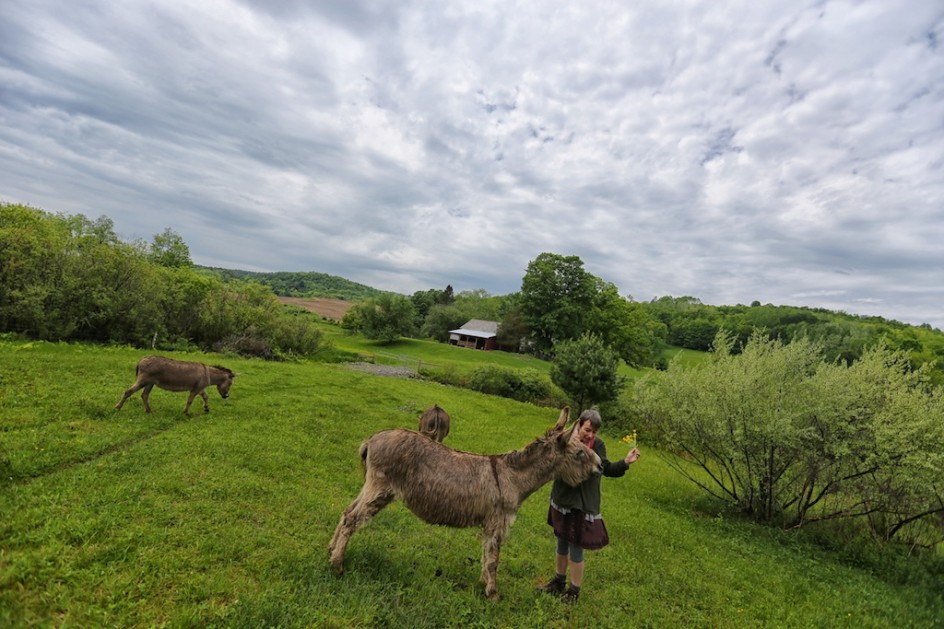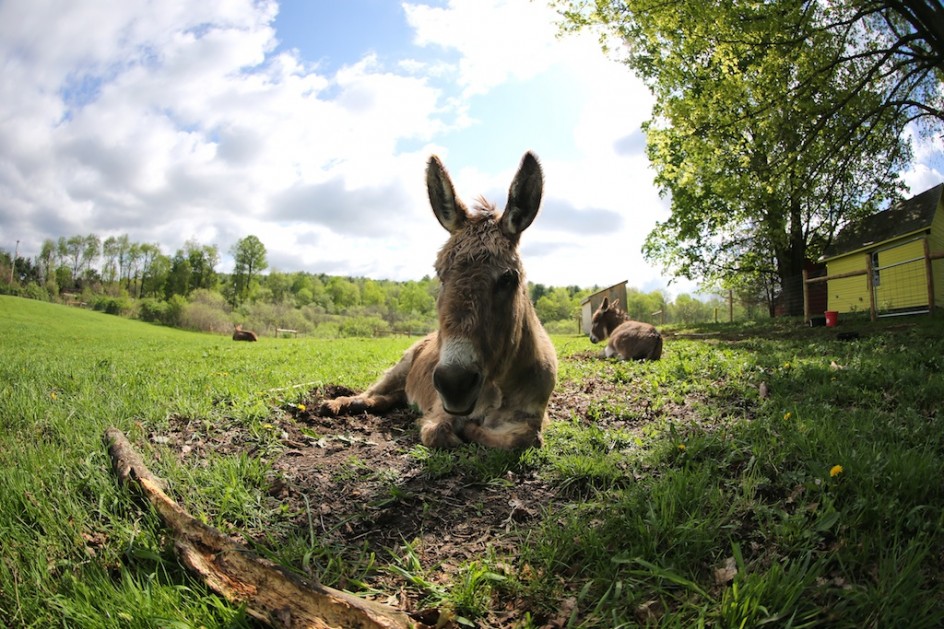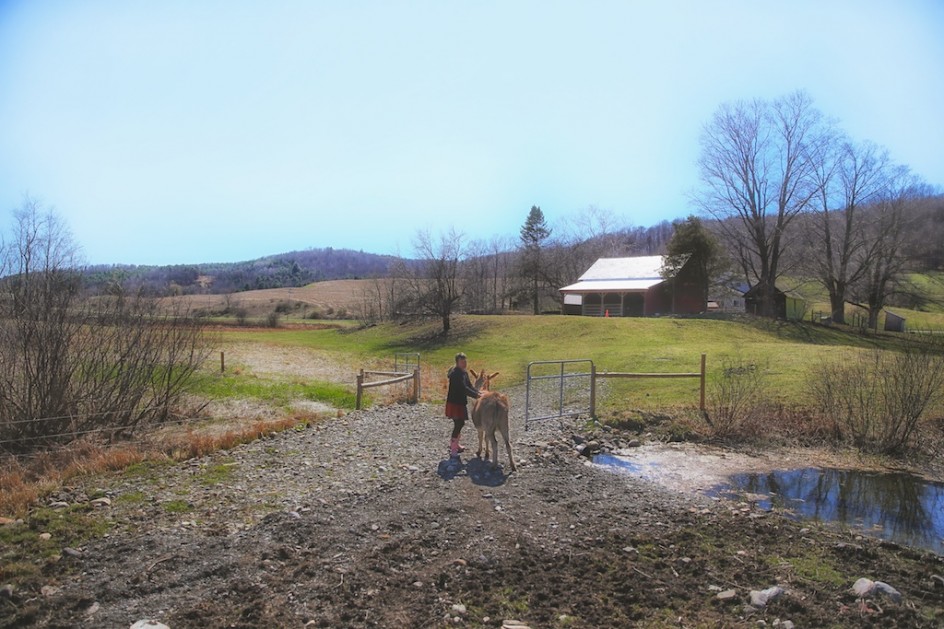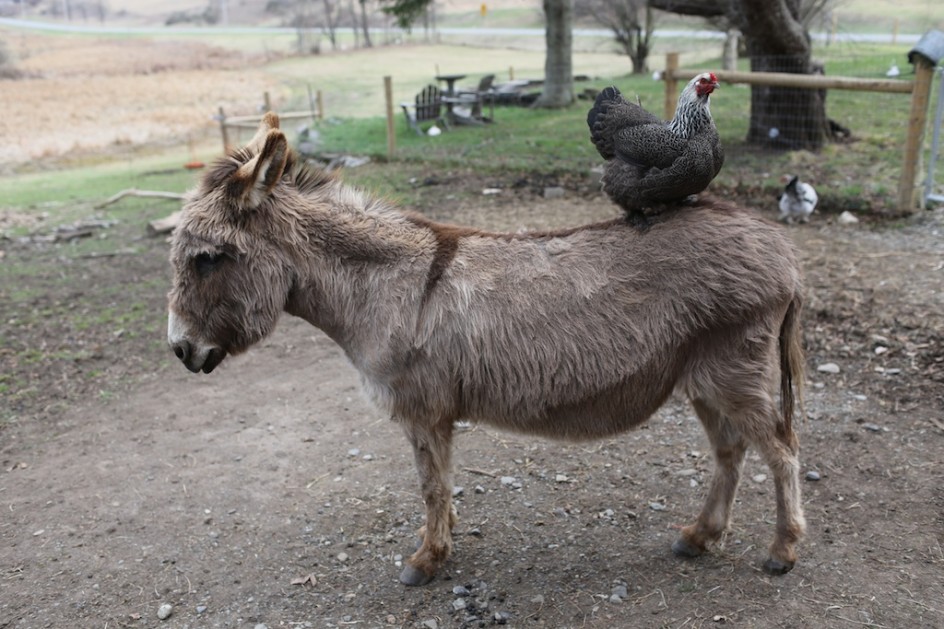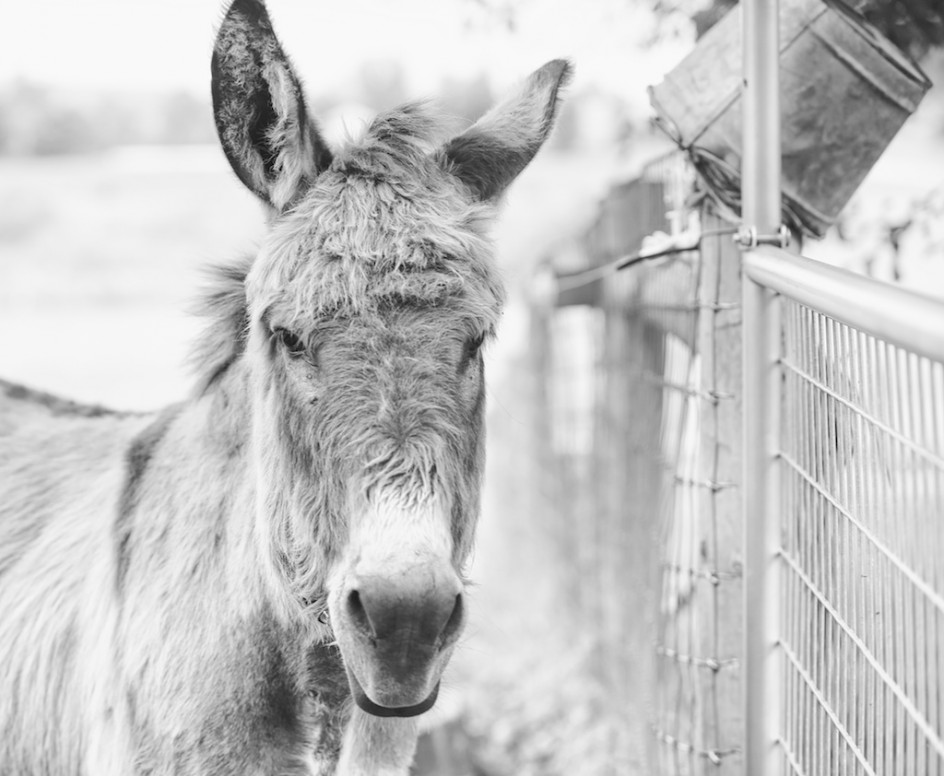
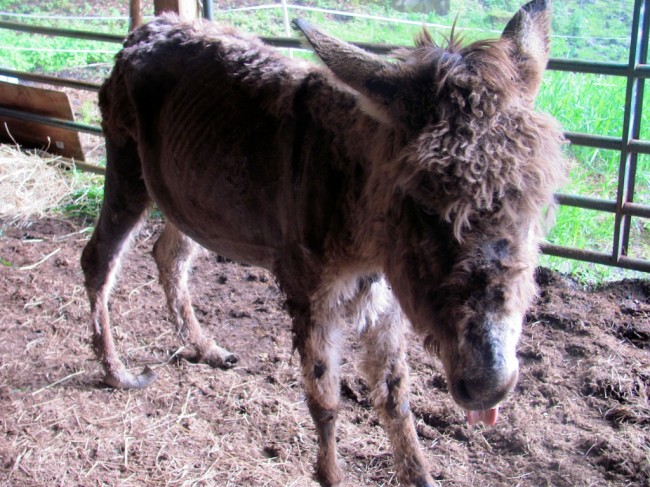
I have a neighbor and friend named Cynthia who is 81-years-old, a farmer’s widow, she has a horse she has owned and loved and cared for for more than 25 years. Her husband died a decade ago, she lives alone. She struggles every month to pay her mortgage, heating oil bills and medical costs, she lives only on Social Security. Her horse is the light in her life. She refuses to abandon him or send him away, or sell him to the auctioneer, who has offered to take him for free. Her horse is old and failing, he eats less and less, the vet says he will go soon – “just like me,” she says, “he is my spirit. When he goes, I will follow.”
The horse stands in the pasture just behind the farmhouse, he is still handsome though old and wobbly, though Cynthia worries he will not make it through another winter like the last one.
She hobbles out every single day to bring him grain and brush his coat. The two are a portrait in love and connection, what animals and people can be, left to themselves. I’m afraid to use it here, for her sake, how sad that is. Last year her big barn collapsed in a snowstorm, there is enough of a frame and roof left to give her horse protection from the wind, rain and snow, but not enough cover him completely. She just has no more money, and little strength.
Three times in the last year, people who call themselves supporters of animal rights have drive by her old farm and called the police and animal control officers, and told them her horse was being abused. None of them have stopped to talk with her. They demanded the horse be taken from her and sent to a rescue farm. Three times, the police have come to her home and frightened her nearly to death with the thought they may take her horse away and the idea that she might be abusing him.
___
More than anything else, the controversy over the New York Carriage Horses and a mounting number of animals in our world, are questions and accusations relating to abuse. The idea of abuse is at the heart of the controversy in New York, it is the word and idea most frequently invoked as a justification for the long campaign against thecarriage trade.
For more than a decade animal rights groups, and most recently, the mayor of New York City, have said flatly and repeatedly that the carriage horses are being abused, that pulling carriages, living in urban stables, working on New York streets constitutes both cruelty and abuse. The statements have been made as facts, as absolute truth, not as questions or even arguments. These organizations maintain that because they are abused, the horses should be removed from the city and sent only to rescue farms, where they will never work again, or be seen by people. The carriage trade would be outlawed, owners and drivers put out of work.
The idea of abuse has been mentioned so angrily and repeatedly it has entered the public consciousness as the premier reality associated with the horses existence. Stop Horse Abuse is the literal slogan of NYClass, the milionaire-funded organization spearheading the move to ban the carriage horses from the city.
__
The idea and meaning of abuse was once more driven home to me yesterday when Ken Norman, our farrier and a passionate lover and rescuer of horses, came to the farm to check on Simon’s feet. I have known Ken for 15 years, I know no one who knows more about horses – and donkeys – or who loves them more. Horses are his life, he is precisely the kind of person the mayor might want to speak with to learn about horses.
Simon is one of our three donkeys.
Above, at the top, is a photograph of Simon I took today. The one beneath it was taken by Ken Norman, our farrier, on the night when the New York State Police removed Simon from a farm and brought him to me. They thought Simon would not make it through the night, they almost put him down out of mercy.
Ken rushed to help Simon and performed emergency work on his hooves, which had not been trimmed in years. Do not get Ken started on how he feels when he hears that the carriage trade people are being accused of abuse. “Those are the luckiest horses in the world,” he says. “Nobody in that city seems to know what abuse is.”
I posted this disturbing photo of Simon and his hooves so that people who love animals and are concerned about the welfare of the carriage horses can understand what abuse really is, and what it really means. This is important because the term and its meaning have been perverted in the carriage horse controversy.
Simon was abused. His hooves had grown out by more than half-a foot when he was found, his teeth were impacted in his jaw, he was nearly starved, his skin was rotted in the cold and turned black. He was covered with lice and sores, he was nearly blind from his infected eyes. He is much better today, although his twisted legs cause him much pain.
Abuse is not an argument. It is not the opinion of NYClass, the mayor, or people sitting in their suburban homes or city apartments with their dogs and cats looking at photos on their computers and thinking the city is no place for big horses, or that work for working animals is cruel and a form of animal abuse.
Animal abuse is a crime, the people committing abuse are subject to arrest and punishment.
According to the American Legal Dictionary, cruelty to animals means this: “the crime of inflicting physical pain, suffering or death on an animal, usually a tame one, beyond necessity for normal discipline. It can include neglect that is so monstrous (withholding food and water) that the animal has suffered, died or been put in imminent danger of death.”
The farmer who abused Simon was not picketed by animal rights demonstrators. There was no campaign to ban his farm or banish him or bar him from his work, there was no argument about whether his treatment of Simon was cruel. The case came from the law, not the fevered imaginations of disconnected people, it was straightforward. He was arrested by the police and charged and convicted of neglecting Simon. A judge convicted him immediately.
The perversion and corruption of abuse is important to me, as it ought to be to any true lover of animals. Simon is one of the animals on my farm who remind me every day what abuse really is and how the very meaning of the term has been co-opted by people who either do not know what it means or have other motives for using the word – raising money, gaining political influence, acquiring property for real estate development.
The Law Dictionary defines cruelty to animals in this way: “The infliction of physical pain, suffering, or death upon an animal, when not necessary for purposes of training or discipline (or in the case of death) to procure food or to release the animal from incurable suffering, but done wantonly, for mere sport, for the indulgence of a cruel and vindictive temper, or with reckless indifference to pain.”
People of good faith may differ on whether the carriage horses should remain in New York, or whether their lives there could be improved. They could be debating the future of animals in our world. But words have meaning and truth matters. So does law in a free society.
There is no evidence of any kind that the carriage horses are being abused. In each of the past five years, an average of 4,000 claims of animal abuse have been reported to city officials in New York. Not one has been made against the carriage horses. In 150 years, no human has died as the result of accidents involving the horses. To gather a moral perspective on the question of the horses and safety in New York, you might want to read this New Yorker Magazine article on the thousands of deaths in New York City in modern times at the hands of automobiles, and the difficulty the city faces in confronting what the magazine calls “killer cars.” The mayor and NYClass propose replacing the horses in Central Park with at least 70 new cars, even as he strives to force 220 working horses out of the city.
In this century, one carriage driver has been arrested and charged with animal cruelty or animal abuse. A driver was cited last December for animal cruelty, on the even of the mayor’s ascent to power. He is alleged to have worked a carriage horse with thrush, a foot infection and carried more passengers than the law permits. He was convicted of the charges in April, and his license was taken away. No carriage driver or owner in New York has been charged for inflicting pain, suffering or death on a carriage horse. No person in the carriage trade has been charged with indulging a cruel and vindictive temper, or with reckless indifference to pain. No driver working today has ever been accused of animal abuse, and is not so accused now.
The horses are monitored by five different city agencies. They get five weeks of vacation, they work an average of six hours a day, they are in the company of other horses every minute of their lives, they cannot work in extreme heat or cold, they live longer on average than horses in the wild or on rescue farms, they have plenty of room to turn around and lie down in their stalls, their stables are cleaned every three hours, and are heated in the winter and air-conditioned in the summer, their very light work consists of pulling carriages on rubber wheels through flat ground, mostly in a vast park designed for them. I don’t see anything in their lives – a score of vets have pronounced them healthy and content – that comes remotely close to the idea of abuse.
When people tell me or message me that the horses in New York are suffering from abuse at the hands of their owners or drivers, I suggest that they report the abuse they are talking about immediately to the police rather than to me, to one of the five agencies in the city who monitor the horses. I am certain that the mayor and the people working for him would be eager to investigate and pursue these cases, and if appropriate, make the necessary arrests. Why, if horse abuse is rampant, is no one being charged with the crime? And if the animal rights organizations know of continuing abuse of the horses, why do they not report this information to the police?
Could anyone who cares about the horses seriously argue that this administration might be covering up these allegedly frequent crimes?
In this world of mirrors and illusions, truth does not seem to come up too often. Abuse is invoked and asserted so often it no longer has any meaning, it has simply become a club to beat the carriage owners and drivers into submission. What a shame for the many animals in the world who are mistreated every day.
Simon reminds us that abuse is not an idea, not a political squabble. Animals and the people who own them have the right to be protected from wanton and reckless claims of abuse that come outside the law, especially from people with no legal authority or electoral mandate or understanding of animals or any moral authority to enter the private lives of people and take away their reputations, way of live, and livelihood – almost always in the name of abuse.
__
The last time the police came to Cynthia’s house, she called me, once again in a panic. “Why won’t they live me alone?,” she always asks me. I do not know what to say.
She simply does not understand why people are accusing her of abusing the horse she has cared for for so many years and loves and has fed and cared for for so long. A police officer came up to me, he was uncomfortable, he said he had no choice but to investigate the claim, people driving by have seen the horse standing by the wrecked barn and call. The officer grew up on a dairy farm. “I know this isn’t abuse, but I have to come. I want to say to these people, look ‘leave her alone,’ she is doing the best she can with her horse, they both are near the end, for God’s sake.”
A group of Cynthia’s friends and neighbors got together and built a small shed alongside the collapsed barn. Her horse will not go into it, he prefers the rafters and shade of the old barn where Cynthia has come for years to brush him. Most of the time, he just prefers being outdoors. It doesn’t matter really. Cynthia is, at least, protected from the new perversion of abuse. Her horse will not be taken from his long and loving life with her in the name of saving him from abuse and cruelty.
I wish the same fate for the New York Carriage Horses.

